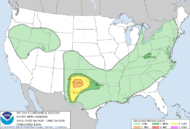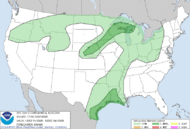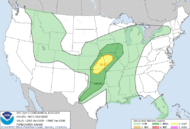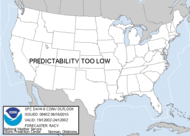Yesterday I posted about the brewing severe weather coverage controversy. Today I will write my opinion on the matter. Print this and take it, along with a few dollars, to Starbucks and you can buy a cup of fancy coffee.
The controversy over what kind of severe weather coverage television stations should provide has reared its head again in Alabama. On Saturday, a very slow moving storm system drifted through the state, training over the same areas, producing numerous tornado warnings but little if any damage. Sunday a major derecho event moved across the state along with 7 confirmed tornadoes. Six of the tornadoes were rated EF1 and one was rated EF0. There were numerous trees down across mostly rural areas of Central Alabama. The greater Birmingham metropolitan area was brushed with several close calls with wall clouds and funnels reported.
On Monday, Paul Finebaum, a popular sports radio talk show host dedicated his four hour program to the issue of severe weather coverage. Sporting events including the NBA playoffs, PGA golf, and a NASCAR race were all preempted for severe weather coverage in the Birmingham and Huntsville television markets. Brad Huffines, Chief Meteorologist with WAAY 31, the ABC affiliate in Huntsville added fuel to the fire by calling in to the Finebaum show, making some not so subtle digs at other stations in the Huntsville and Birmingham markets for overdoing the severe weather coverage.
I have been an observer of weather and mass media in Alabama for over 35 years. I have a degree in communication. Other than that, I have no real claim to fame. I know several people in the weather community and they are some of the most sincere, dedicated, and passionate people I know when it comes to taking their jobs seriously.
I think it is time to take some of the emotion out of this issue and look at some facts, and let the conclusions follow. It is hard to argue that there are certainly a lot of false alarms. Approximately 80 percent of tornado warnings are not later verified by a confirmed touchdown. On top of that, 75 percent of all tornadoes are EF0 and EF1, and produce only 4 percent of all deaths. 96 percent of all tornado-related deaths occur within 25 percent of the tornadoes (EF2-5). So, let’s take a closer look at what we are dealing with here:
100 tornado warnings
20 tornadoes confirmed
15 EF0-EF1
5 EF2-EF5
What that tells us is that out of 100 tornado warnings, approximately five or six are likely to result in deaths. If broadcast meteorologists could identify the “correct” five or six percent of warnings, then coverage could be scaled back the other 95 percent of the time. That sounds like a great idea, but is it possible in 2009?
Has technology and spotting improved significantly enough to accomplish that? I am going to say “not usually”. NEXRAD really improved lead time on warnings by showing meteorologists where storms are rotating. Street level mapping and other enhancements have been invaluable tools. But the fact remains that NEXRAD does not show what is going on in the lower levels of the atmosphere close to the ground where a tornado would be occurring. NWS Skywarn spotters and skywatcher teams like James Spann has assembled at ABC 33/40 in Birmingham have helped. Storm chasers such as John Brown and Brett Adair, along with skycam networks have really enhanced the ability of forecasters to obtain “ground truth.” Improved communication with cellular phones and “smart phones” has made almost every Alabamian a “storm spotter” with the ability to immediately call in a report or send an actual image back to television stations. All of these things are great, but they are still not quite enough to tell broadcast meteorologists all they need to know.
Some might suggest that one can look at the severe parameters for a given day and say that the conditions are not favorable for significant tornadoes. Some would also say that there are obvious signatures on radar that accompany a significant tornado. I would like to believe these things, but it simply isn’t always true. How many “high risks” have busted? How many “slight risks” have turned into higher-end events? As far as radar, there have been numerous times when major rotation was showing up on radar and nothing happened at the ground.
Since meteorology is an inexact science this is where prudence and common sense need come into the picture. James Spann is famous for saying that the meteorological community needs more humility. Retired Birmingham NWS forecaster J.B. Elliott is famous for saying, “when it comes to severe weather, expect the unexpected”.
The caution I would have at discontinuing the policy for long form, continuous coverage is that it is better to be safe than sorry. Another thing James Spann has said to prospective meteorologists is “to be ready for the defining moment in your career.” The truth is, no one in weather knows exactly when that will or will not happen.
Some have proposed alternatives, such as double-box programming. That will work somewhat for sports events but not for much else. What about the fact that most programs are not live and can be shown at a different time? What about the fact that most programs can be seen online? What about asking Congress to remove the legal barriers so that satellite and cable providers could offer two feeds of every network broadcast? Sports fans, what about using alternative feeds on satellite when available? What about listening to the game on radio, when available? Finally, what about putting the lives of others as a higher priority than an Alabama game or “Desperate Housewives”? By the way, I am a big Alabama fan. I would hate to miss half of the Iron Bowl because of a warning, but I could work around it.
What about the “customers/viewers”? In America we like to say the customer is always right. But which customers do we listen to most closely? Do we listen to chronic whiners who call and email the station and cuss out the staff because their “story” or their NASCAR race was interrupted? Or do we listen to the ratings? It seems to me that ratings are a better measure of the customers’ overall opinions. In Huntsville, Dan Satterfield at WHNT 19 and Brad Travis at WAFF 48 usually have the highest ratings. In Birmingham James Spann at ABC 33/40 has generally had the highest ratings. Is it a coincidence that these stations provide the most extensive coverage of storm events? I think not.
Finally, here is a hypothetical situation to ponder. Pretend it is May 28, 2009. The SPC places the Tennessee Valley of North Alabama under a slight risk. Instability levels are high but there is a strong cap in place across the state. Models did not predict much shear in the atmosphere but a renegade boundary from storms the previous day is reenergized in the heating of the day around Interstate 20. At about 2:00 storms begin to develop along the line and the SPC issues a Severe Thunderstorm Watch. Meteorologists have an eye on the radar but are not really in full severe weather mode, going about typical tasks. Suddenly rotation is seen in a storm that has developed on the Bibb/Shelby County line, southwest of the Birmingham suburb of Hoover. The NWS issues a Tornado Warning. Television stations put a “crawl” across the bottom of the screen and break in momentarily before going back to regular programming. No one at the station really wants to hear little old ladies complaining about missing a critically important episode of “General Hospital” that day. Very quickly this isolated storm goes into rotation in the lower levels and produces a tornado which moves along Highway 150. It produces EF3 damage for 5 miles and damages numerous businesses, schools, churches and homes in the Hoover area. Sadly, because it is a populated area, there are ten fatalities. Broadcast meteorologists only begin coverage in earnest after the tornado has dissipated and the damage reports start coming in. Will they wish they had been more prepared to provide wall to wall coverage the moment the tornado warning was issued? Will they be criticized for not “doing their jobs”? Will the Birmingham News headline read, “Tornado Strikes Hoover Without Warning, 10 Killed”? Will families ask for an investigation? Will there be a grieving parent who will always wonder “what if” their beautiful 10 year old daughter had been able to take cover in time? Will the public then demand wall to wall coverage during every tornado warning? I think the answer to all of those questions is “yes”, or “very likely”.
The question is not whether a significant tornado will cause fatalities in Alabama but rather when will it happen. The other question is will we be ready? I would like to see a modified version of continuous “wall to wall” coverage, if it were feasible. I am not sure that it is. Even if it was feasible, people would still complain about the frequent interruptions. I vote for broadcast media outlets in Alabama to continue continuous coverage during tornado warnings in their market areas.
...
Cliff Mass Weather Blog
Frosty Morning and an Extraordinary Land Breeze - Much of the state experienced a hard freeze last night, a combination of unusually cold air and clear skies, which allowed the earth to radiate heat to spa...
7 hours ago










7 comments:
People should get their warnings from NOAA Weather Radio. Not the media. However, in the real world, that is not the case. Most people get their warnings from television.
I like the wall to wall coverage - then again I am interested in weather. Wonder what the majority of people think about this issue? Wonder if there have been some studies into the subject.
There will always be people who complain, though. I doubt that ever ends.
I like the idea of two streams - stations are sort of doing that now. The digital signals allow a 24/7 weather channel for our local stations.
Very well written post, Mike.
I have a few thoughts. I used to be solidly in the camp that there should be wall-to-wall coverage for all Tornado Warnings. Now, I don't really feel that way anymore. I'm not so sure how consistent it is for a TV station to go wall-to-wall during all Tornado Warnings and very rarely for Severe Thunderstorm Warnings. The biggest reason is this: It only takes one tree falling through a mobile home to end a life. This happened just a few weeks ago near Somerville (it was determined that fatality was caused by straight line winds - the tornado path was about a mile away from that mobile home). If TV stations want to be consistent, then they must go wall-to-wall for all Severe Thunderstorm Warnings too.
It is at this point that I somewhat agree with Brad Huffines, or at least certain points that he makes. The quick spin up tornadoes that we get along shallow lines of thunderstorms and QLCSs are difficult to detect with much or any lead time. However, they are almost always short lived. Now, this doesn't diminish the danger at all. They frequently develop with little or no lead time. I'm just arguing that we're desensitizing the public to Severe Thunderstorm Warnings if we treat certain "weak tornado" situations differently than we are severe thunderstorms.
I also agree with Brad that there has to be a certain degree of personal responsibility. We will strive to put out the best warnings we can, but no one (the NWS, nor the TV stations) can hand deliver the warnings to every person in the area.
My only problem with some of the local stations is that some of the local meteorologists (usually particular ones, and the same ones every time) have a tendency to question our warnings without asking us for our thoughts. We have a chat room designed for that specific purpose, but it is rarely used for that. What those folks don't seem to realize is...Hytop isn't the only radar in north Alabama, and it certainly doesn't always provide the best low-level picture of storms near Huntsville. It's no surprise that with these low-topped storms, some of the local university/TV radars - not in higher terrain - can see the low-level circulation MUCH more clearly. The great irony is that some of these same stations don't always utilize their own radar to take advantage of this fact.
I'm not sure about hype. I usually don't get to watch the local TV stations during weather, because I'm usually busy at work or out chasing. (In fact, most of the coverage I see is from the recordings you upload to YouTube, thanks!) I know a lot of hype is perpetrated by slogans and other things management push on to the TV mets. I will say this. One particular TV meteorologist's free use of the words "Tornado Emergency" on his own volition greatly troubles me...particularly because he liberally rails on the NWS for desensitizing the public. If you say "Tornado Emergency" every time there is a report of a tornado, then what does that do to a plain old Tornado Warning? What if there is a strong tornado going through a heavily forested area and no one knows it's there until it hits a house? Is that less of a Tornado Emergency than one of these quick spin-up tornadoes that happened to be spotted by someone? There is a very good reason the NWS doesn't use "Tornado Emergency" every time a tornado is reported.
Now, I'm not saying that we're perfect. We have people who are too liberal with warnings and people who are too conservative with warnings. I can't issue them yet, so I don't know which extreme I'll fall into yet. We usually try to cancel warnings as soon as possible, but there are some times when we let a warning ride until expiration time after it has weakened because of the potential for circulation to redevelop.
This is why I think it's fine for TV meteorologists to use their own judgment to determine when they should remain wall-to-wall. I just think they should give us the benefit of the doubt instead of openly questioning us in front of everyone. If they ask us, and they still don't agree with us...then I have no problem with that at all. I have a great deal of respect for the radar interrogation capabilities of most of the TV mets here. And that's my incredibly biased perspective of things. :)
Oh, and also, I understand that Fox 6 and NBC 13 are very competitive with 33/40 and (at least as of a couple years ago) beat them regularly. Of course, from what I understand, those stations stay wall-to-wall most of the time too.
Now that I've probably said too much already. Even though it carries no weight legally, the above thoughts are completely mine, and not that of my employer.
Daniel L --- Thanks so much for your very detailed and well thought out comment. Do you think that these same broadcast meteorologists, with the information at their disposal, will be able to distinguish between EF0-EF1's and EF2 and greater during their live coverage?
I wonder if we would be having this conversation if this event had occurred during the middle of the night and all that got pre-empted was a Billy Mays informercial? But it was sporting events and people in this state have no concept of what's important when sporting events are involved.
And lets all be honest. Paul Finebaum criticizing the Birmingham media is like the pot call the kettle black. If EVER there was someone who sensationalized the picayune events of the day it's him and the same 5 or 6 callers who he allows to call and set up his ramblings.
That's just my opinion and I'm also a big sports fan. But I do know how to keep life in perspective.
I'm going to comment on this with all due respect to the local meteorologists who I have tons of respect for...
Let's look at the facts...
Long-form weather coverage, especially in some of these recent events which require wall-to-wall for several straight hours, cost tens of thousands of dollars in ad revenue. This at a time of a very tough economy.
WAAY-TV 31 in third in the Huntsville market in local news coverage. No real way to gauge severe weather coverage but it will likely fall along those same lines.
With all that in mind...what does WAAY 31 have to lose taking this approach? A worse-case scenario they remain third in the ratings. Best case they pick up viewers during severe weather events. However, as one Alabama meteorologist has said before...you're not going to win in the ratings cutting back on coverage.
Ironically...WAAY-31s decision may have backfired a bit this weekend. The competition looked very, very vulnerable this weekend. 48 was last on the air during most of the tornado warnings. WHNTs coverage was covered mostly by Jerry Hayes until Dan or Spencer showed up. Christina Meeks...while I'm sure a great person, looked lost on the air.
Perhaps a golden opportunity to gain on the competition lost.
I've been on the phone with my son while he was watching ABC33/40 and I've had their live stream up on my computer at the same time. Believe me, I'd love to have that thorough of coverage up here in the northeastern Indiana area!
Perhaps because I grew up with educational television, I rarely object to weather coverage, especially when it does a good job of explaining the science behind the weather. For this reason, I really like Dan Satterfield's coverage. Even if a warning is no where close to my area, I still find it interesting to learn about the storm's development and like to understand what storm features prompted concern.
There doesn't seem to be quite so much "science" to some of the other weather reports, which are little more than warnings for people in certain locales to take cover - I can get that much from my weather radio.
I was surprised to see Brad Huffines basically deriding his competitors on the air recently for their extended weather coverage. Certainly there is a difference of option here, but this doesn't seem like a very professional way to deal with the issue.
Post a Comment